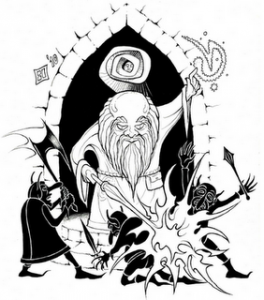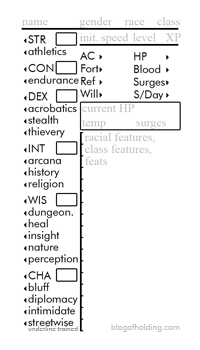My old houserules for leveling magic items mean that every piece of magical treasure has the potential to gain power in ways that the players can’t predict. Furthermore, WOTC recently invented the concept of the “rare magic item,” but haven’t given us lots of examples.
While some items may get mechanically better (for instance, a +1 sword becomes a +2 sword), it’s more challenging to improve items that don’t have numeric bonuses. I thought I’d go through the Wondrous Items in the 4e Player’s Handbook and give examples of how each could gain powers that reflect their history.
Everlasting Provisions
This item is provided solely to give PCs a rationale for ignoring food logistics (which they do anyway). Still, even a magic picnic can have a personality of its own.
1. The Guildmaster’s Everlasting Provisions of Coercion
Among the daily items in these Everlasting Provisions is a bottle of fine wine. When the food is created, the user can cause the bottle to either be normal wine, a wine that infects its drinker with Cackle Fever, or a wine that provides a Cackle Fever antidote. The difference between these wines may not be determined by nonmagical means.
The Guildmaster used the diseased wine, and the promise of an antidote, to persuade many people to do her favors who might not otherwise have done so.
2. Chef Aron’s Everlasting Provisions of Inconsistent Quality
Besides the normal, filling meals, every day’s provisions come with beautiful pastries. Each day, the pastries have different effects on all consumers (roll d6):
1: Illness. After an hour, the eaters become sick. Unless they make a DC 17 Endurance check, they lose a healing surge and are Weakened for an hour. On a failure, the check and consequences are repeated every hour until they either succeed on the Endurance check or take an extended rest.
2: Addiction. The consumer can’t stop thinking about the desserts. The next day, the consumer will be Weakened until they eat one of the pastries again or take an extended rest.
3: Normal. The pastries are delicious.
4: Extra healing. The first healing surge spent before the end of the day heals additional hit points equal to the consumer’s Healing Surge.
5: Extra energy. If the consumer has less than two Action Points, they gain an Action Point.
6: Glittering Prizecake of Wonder. Each consumer finds a magical trinket baked into their pastry: it may be equipped into an empty ring, neck, or head slot. While equipped, all skills gain a +2 item bonus. The trinket disappears at the next extended rest.
Chef Aron had no natural gift for cooking, but after doing a favor for a fey lord his banquets would occasionally lead to surprising results.
3. Jeks’ Everlasting Provisions of Shared Understanding
Until the next extended rest, everyone who shares the glasses of whiskey that accompany this meal gets +5 bonuses to Diplomacy and Bluff and -5 penalties to Insight.
Behold the magical tablecloth of Jeks, a diplomat whose conferences usually led to quick agreements, although not always ones of great wisdom.












